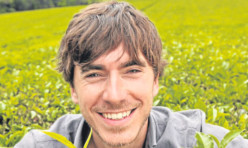
Simon’s tea trail led up a surprising path and revealed what was brewing under the surface.
My fiance’s brother lives in Beijing and as a Christmas present my beloved had the idea of sending him a food parcel made up of items he couldn’t get there. The first thing she put in it was a box of tea bags, to which I pointed out that there’s a reason the saying “all the tea in China” meant an abundance of something.
It’s an illustration of how we don’t always consider how far the items in our kitchen cupboard have travelled to get there, which was why Simon Reeve’s The Tea Trail made enlightening viewing.
An easy watch usually, Simon had blotted his copybook with the recent Pilgrimage, his blank canvas style of reporting not suited to a journey from Lindisfarne to Lincoln which we’re already familiar with.
I wondered whether he could add anything to Victoria Wood’s two-part history of tea which aired last September but he was back on track following the journey of a tea leaf from plantation to pot.
First off he informed me that China (and India) had been replaced by East Africa as our major exporter of tea and he was in Kenya to find out if an industry that employs five million of its inhabitants had benefited the country.
It all started with jollity Simon travelled from the port of Mombasa on “the lunatic line” and headed inland to meet smiling local farmers and members of the Maasai tribe, who were augmenting their traditional diet of milk, meat and cow’s blood with “grow your own” cuppas.
There was also a very funny moment where an elderly tribeswoman was interrupted talking about the Maasai way of life by an incoming call on her mobile phone.
But then the brew got altogether darker as Simon discovered how truck drivers transporting tea across the country had fuelled the country’s Aids epidemic and that children were working as pickers at well below the minimum wage. I wasn’t expecting a programme about tea to feature the work of a woman who hands out 1,500 condoms a night and some awkward questions for Unilever.
It all left a funny taste in the mouth.

Enjoy the convenience of having The Sunday Post delivered as a digital ePaper straight to your smartphone, tablet or computer.
Subscribe for only £5.49 a month and enjoy all the benefits of the printed paper as a digital replica.
Subscribe